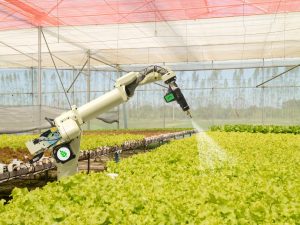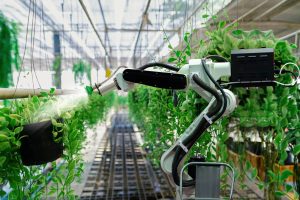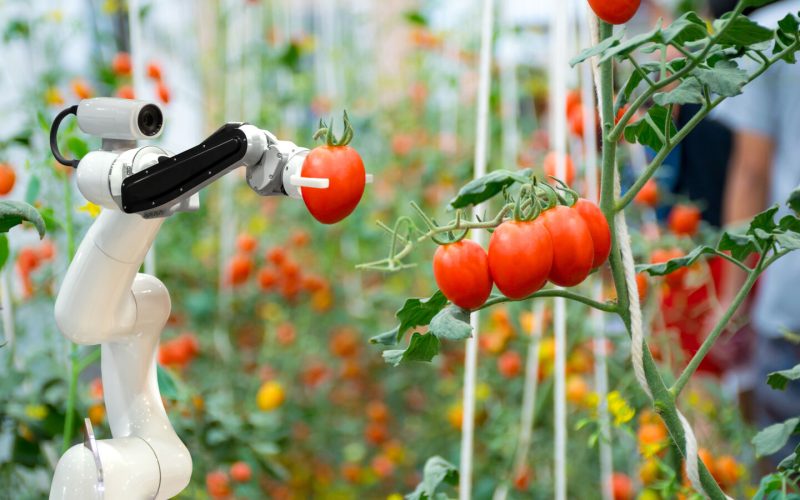In recent years, the integration of Artificial Intelligence (AI) in agriculture has revolutionized the way food is produced, managed, and distributed. AI technologies, including machine learning, computer vision, and robotics, offer innovative solutions to challenges faced by farmers and agricultural stakeholders worldwide. This article explores the applications of AI in agriculture, its benefits, challenges, and future prospects for enhancing food production sustainably.
The Role of AI in Modern Agriculture

Agriculture is a complex and dynamic industry that requires efficient management of resources, optimization of crop yields, and mitigation of environmental impacts. AI technologies provide valuable tools for farmers to make data-driven decisions, optimize processes, and respond to changing conditions in real-time.
Precision Agriculture
Precision agriculture is a key application of AI in farming, focusing on optimizing inputs such as water, fertilizers, and pesticides to maximize crop yields while minimizing environmental impact. AI-driven systems analyze data from sensors, satellite imagery, and weather forecasts to provide insights into soil health, crop growth patterns, and pest infestations.
Benefits of Precision Agriculture:
Resource Efficiency: AI helps farmers use resources more efficiently by applying inputs only where and when they are needed, reducing waste and costs.
Increased Yields: By optimizing crop management practices, precision agriculture can lead to higher yields and improved crop quality.
Environmental Sustainability: Reduced use of chemicals and water conservation contribute to sustainable farming practices, minimizing the ecological footprint of agriculture.
Crop Monitoring and Disease Detection:
AI-powered systems can monitor crops continuously using drones, satellites, and ground-based sensors. Machine learning algorithms analyze images and sensor data to detect early signs of plant diseases, nutrient deficiencies, and water stress. Early detection allows farmers to take timely action, preventing crop losses and improving overall plant health.
Benefits of Crop Monitoring with AI:
Early Intervention: AI can detect subtle changes in plant health that may not be visible to the naked eye, enabling prompt intervention before diseases spread.
Improved Yield Predictions: Accurate monitoring and data analysis improve yield predictions, helping farmers plan harvests and manage logistics more effectively.
Reduced Chemical Use: Targeted application of treatments based on AI insights reduces the need for pesticides and fertilizers, promoting sustainable farming practices.
Autonomous Farming Equipment

AI-powered robotics and autonomous vehicles are transforming farming operations by automating tasks such as planting, harvesting, and irrigation. These technologies use sensors, cameras, and AI algorithms to navigate fields, identify crops, and perform precise actions without human intervention.
Benefits of Autonomous Farming Equipment:
- Labor Efficiency: Automation reduces the need for manual labor, allowing farmers to focus on strategic decision-making and higher-value tasks.
- 24/7 Operations: Autonomous systems can work around the clock, maximizing productivity and operational efficiency.
- Precision and Consistency: AI-driven equipment performs tasks with high precision and consistency, resulting in uniform crop management and reduced operational errors.
Challenges and Considerations
While AI offers significant benefits to agriculture, several challenges and considerations need to be addressed for widespread adoption and success:
-
Data Quality and Integration
AI algorithms depend on high-quality data for accurate predictions and recommendations. Integrating data from various sources, such as sensors, satellites, and historical records, can be complex and requires robust data management systems.
-
Cost of Technology Adoption
The initial cost of AI technologies, including sensors, drones, and AI-enabled equipment, can be prohibitive for small-scale farmers and developing regions. Cost-effective solutions and financial incentives are needed to promote equitable access to AI in agriculture.
-
Technical Expertise and Training
Effective use of AI in agriculture requires training farmers and agricultural professionals in data analytics, AI applications, and technology maintenance. Investing in education and skill development is essential for maximizing the benefits of AI technology.
-
Ethical and Social Implications
AI adoption raises ethical concerns related to data privacy, algorithmic bias, and the socioeconomic impact on rural communities. Safeguarding data privacy, ensuring fairness in AI algorithms, and addressing the needs of all stakeholders are critical considerations.
Competitive Table
| Company/Organization | AI Application | Key Features | Impact on Agriculture |
| John Deere | Precision Agriculture | AI-driven machinery, soil sensors, automated guidance | Enhanced crop management, resource efficiency |
| IBM | Watson Decision Platform for Agriculture | Crop monitoring, disease prediction, weather forecasting | Improved yield predictions, risk management |
| Blue River Technology | See & Spray | Computer vision, targeted herbicide application | Reduced herbicide use, weed management |
| Climate Corporation (Bayer) | Climate FieldView | Satellite imagery analysis, field insights | Optimized planting decisions, field variability management |
| Microsoft | FarmBeats | IoT sensors, data analytics | Data-driven insights, farm optimization |
Analysis Table
| Aspect | Traditional Methods | AI-Enhanced Methods |
| Crop Monitoring | Visual inspection, manual sampling | Remote sensing, AI-driven image analysis |
| Pest and Disease Control | Manual observation, broad-spectrum chemicals | Precision application, targeted treatments |
| Irrigation Management | Scheduled or manual irrigation | Sensor-based monitoring, automated irrigation |
| Yield Prediction | Historical data analysis | Real-time data analytics, machine learning |
| Labor Efficiency | Manual labor intensive | Autonomous machinery, robotic systems |
Future Prospects

- AI-Integrated Ecosystems: Integration of AI with IoT and big data analytics will create interconnected agricultural ecosystems capable of real-time decision-making and adaptive management.
- Sustainable Practices: AI will drive the adoption of sustainable farming practices by optimizing resource use, reducing environmental impact, and promoting biodiversity.
- Global Food Security: AI-enabled technologies will play a crucial role in addressing global food security challenges by enhancing productivity, resilience, and efficiency in food production.
- Personalized Agriculture: AI-driven personalized farming solutions will cater to specific crops, regions, and farming practices, ensuring tailored recommendations and optimized outcomes.
- Policy and Regulation: Continued development of policies and regulations will be essential to ensure ethical AI use, data privacy protection, and equitable access to technology.
Conclusion
AI is transforming agriculture into a data-driven, precision-focused industry capable of addressing global challenges such as food security, environmental sustainability, and resource management. By harnessing the power of AI technologies, farmers and agricultural stakeholders can make informed decisions, optimize productivity, and improve livelihoods.
While challenges such as data management, cost, and ethical considerations remain, ongoing advancements and collaborative efforts are paving the way for a sustainable and resilient future in agriculture. The integration of AI holds immense potential to revolutionize food production systems and ensure a thriving agricultural sector capable of feeding a growing global population.
In conclusion, AI in agriculture represents a transformative force that promises to enhance food production efficiency, sustainability, and resilience. By embracing AI technologies and addressing associated challenges, we can build a more secure and sustainable future for agriculture and food systems worldwide.










